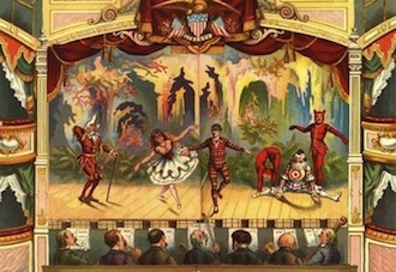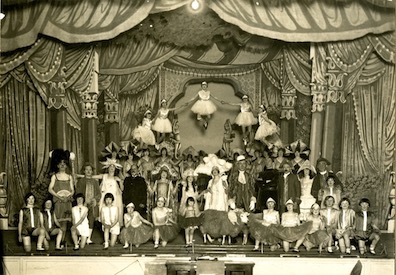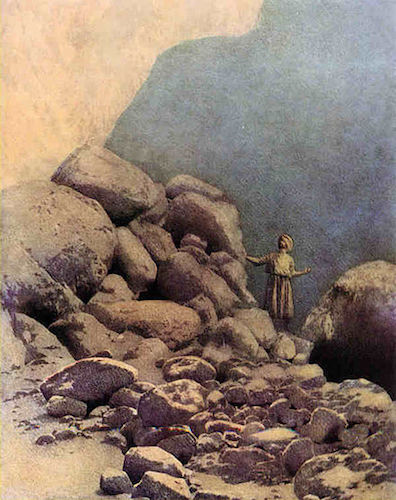Pantomime originated in the ancient world. The Greek name
originally indicated that the actor or actors “imitate all,"
and quite a bit is known about a low Roman art form of that
name, which featured a male dancer telling mythical or
legendary stories. But the modern form can more plausibly be
traced back to the Mummers Play
of medieval England and the Commedia dell’arte of
Renaissance Italy. Theaters in Restoration and 18th century
England adapted elements of the Commedia, and in
the early years of Queen Victoria's reign a new kind of
popular but sophisticated show took shape, based on children’s
fairy tales that everyone in the audience could be assumed to
know, including northern European ones like Cinderella, Mother
Goose, Dick Whittington, and Humpty Dumpty, and also exotic
foreign stories like Aladdin, Ali Baba, Sinbad, and Robinson
Crusoe. These entertainments, which spread to all the farflung
parts of the empire, were, like mummers' plays, usually
performed in the Christmas and New Year season.
Using one fairy tale as a broad canvas, the shows featured
many diverse kinds of free, improvisatory entertainment:
dances, well-known popular songs set to new lyrics,
cross-dressing roles, slapstick comedy, evil villains and good
fairies, clowns, jugglers, acrobats, topical allusions and
jokes, sexual innuendo, appearances by local guest stars, and
frequent audience participation: watchers were expected to
shout out suggestions to the performers and sing along with
well-known songs. The story line ran very loosely through all
these incidentals, and tended to be wrapped up quickly and
unrealistically.
The "Turko the terrible" that Stephen
thinks of in Telemachus, and Bloom in Calypso,
had been performed in Dublin for decades. Thornton notes
that William Brough’s pantomime Turko the Terrible; or,
The Fairy Roses, first performed in 1868 at London's
Gaiety Theatre, was adapted by the Irish author Edwin Hamilton
for performance in Dublin's Gaiety Theatre, first in 1873 and
then many times more in the remainder of the 19th century.
Bloom thinks of Turko as he imagines himself wandering through
the streets of a Middle Eastern city. In Circe,
Molly’s father, Major Brian Tweedy, acquires this exotic
aspect.
"Old Royce," whom Stephen imagines playing
the role, was Edward William Royce, an English comic actor who
often performed parts in pantomimes. His presence in Stephen's
thoughts may owe to the fact that he appeared as Turko in
performances of an unrelated pantomime that Joyce could well
have attended. Robert Martin Adams observes that in the Sinbad
the Sailor of 1892-93, "Mr. E. W. Royce was one of the
featured performers; and his appearance was billed as the
first since his return from Australia. He took the part of
Turko the Terrible, not that this part was an invariable
feature of Sinbad the Sailor...but because, as an old
Dublin favorite, he had to be worked in somehow" (Surface
and Symbol 77-78).
In Ithaca Bloom thinks of “the grand
annual Christmas pantomime Sinbad the Sailor,”
performed in December 1892 and January 1893 at the Gaiety
Theatre. As the poster reproduced here shows, he correctly
identifies the theater manager as "Michael Gunn, lessee of
the Gaiety Theatre," but he is quite mistaken that the
show was "written by Greenleaf Whittier." An obscure
author named Greenleaf Withers penned the script, not the
famous (and highminded) 19th century American poet John
Greenleaf Whittier. Adams points out this mistake, as well as
the fact that Joyce has combined two of the actresses, Kate
Neverist and Nellie Bouverie, into "Nelly Bouverist,
principal girl."
Adams also reflects on the many pieces of information that
Joyce learned about Sinbad (some included in the
account in Ithaca, and many others omitted) from an
advertisement touting the show that ran on p. 4 of the Freeman's Journal on 24
and 26 December 1892. Among the details in the ad was an
announcement of a spectacular episode in scene 6:
GRAND BALLET
of
DIAMONDS
and
SERPENTINE DANCE
Bloom recalls wanting to write "a topical song
(music by R. G. Johnston)" to insert into "the sixth
scene, the valley of diamonds, of the second edition (30
January 1893)" of the pantomime. The changing of
"ballet" into "valley" in all editions of the novel (Gabler's
included) might be supposed to represent a failure of memory
on Joyce's part or Bloom's. But "the valley of diamonds,"
in the second of Sinbad's seven voyages, is a place where
diamonds lie scattered about on the ground. Merchants harvest
them by throwing out pieces of meat that are snatched up by
giant birds called rocs, then driving the birds away from
their nests and collecting the diamonds that have stuck to the
meat. As he drops off to sleep Bloom is still thinking of Sinbad, and
of rocs.



